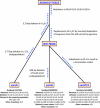Human cytomegalovirus: taking the strain
- PMID: 25894764
- PMCID: PMC4439430
- DOI: 10.1007/s00430-015-0411-4
Human cytomegalovirus: taking the strain
Abstract
In celebrating the 60th anniversary of the first isolation of human cytomegalovirus (HCMV), we reflect on the merits and limitations of the viral strains currently being used to develop urgently needed treatments. HCMV research has been dependent for decades on the high-passage strains AD169 and Towne, heavily exploiting their capacity to replicate efficiently in fibroblasts. However, the genetic integrity of these strains is so severely compromised that great caution needs to be exercised when considering their past and future use. It is now evident that wild-type HCMV strains are not readily propagated in vitro. HCMV mutants are rapidly selected during isolation in fibroblasts, reproducibly affecting gene RL13, the UL128 locus (which includes genes UL128, UL130 and UL131A) and often the U(L)/b' region. As a result, the virus becomes less cell associated, altered in tropism and less pathogenic. This problem is not restricted to high-passage strains, as even low-passage strains can harbour biologically significant mutations. Cloning and manipulation of the HCMV genome as a bacterial artificial chromosome (BAC) offers a means of working with stable, genetically defined strains. To this end, the low-passage strain Merlin genome was cloned as a BAC and sequentially repaired to match the viral sequence in the original clinical sample from which Merlin was derived. Restoration of UL128L to wild type was detrimental to growth in fibroblasts, whereas restoration of RL13 impaired growth in all cell types tested. Stable propagation of phenotypically wild-type virus could be achieved only by placing both regions under conditional expression. In addition to the development of these tools, the Merlin transcriptome and proteome have been characterized in unparalleled detail. Although Merlin may be representative of the clinical agent, high-throughput whole-genome deep sequencing studies have highlighted the remarkable high level of interstrain variation present in circulating virus. There is a need to develop systems capable of addressing the significance of this diversity, free from the confounding effects of genetic changes associated with in vitro adaptation. The generation of a set of BAC clones, each containing the genome of a different HCMV strain repaired to match the sequence in the clinical sample, would provide a pathway to address the biological and clinical effects of natural variation in wild-type HCMV.
Figures




Similar articles
-
Genetic Stability of Bacterial Artificial Chromosome-Derived Human Cytomegalovirus during Culture In Vitro.J Virol. 2016 Mar 28;90(8):3929-43. doi: 10.1128/JVI.02858-15. Print 2016 Apr. J Virol. 2016. PMID: 26842472 Free PMC article.
-
Reconstruction of the complete human cytomegalovirus genome in a BAC reveals RL13 to be a potent inhibitor of replication.J Clin Invest. 2010 Sep;120(9):3191-208. doi: 10.1172/JCI42955. Epub 2010 Aug 2. J Clin Invest. 2010. PMID: 20679731 Free PMC article.
-
Impact of sequence variation in the UL128 locus on production of human cytomegalovirus in fibroblast and epithelial cells.J Virol. 2013 Oct;87(19):10489-500. doi: 10.1128/JVI.01546-13. Epub 2013 Jul 24. J Virol. 2013. PMID: 23885075 Free PMC article.
-
Human cytomegalovirus tropism for endothelial/epithelial cells: scientific background and clinical implications.Rev Med Virol. 2010 May;20(3):136-55. doi: 10.1002/rmv.645. Rev Med Virol. 2010. PMID: 20084641 Review.
-
The power of human cytomegalovirus (HCMV) hijacked UL/b' functions lost in vitro.Acta Virol. 2020;64(2):117-130. doi: 10.4149/av_2020_202. Acta Virol. 2020. PMID: 32551781 Review.
Cited by
-
CMV-induced Hearing Loss.Newborn (Clarksville). 2023 Oct-Dec;2(4):249-262. doi: 10.5005/jp-journals-11002-0081. Epub 2024 Jan 5. Newborn (Clarksville). 2023. PMID: 38348106 Free PMC article.
-
Targeting Conserved Sequences Circumvents the Evolution of Resistance in a Viral Gene Drive against Human Cytomegalovirus.J Virol. 2021 Jul 12;95(15):e0080221. doi: 10.1128/JVI.00802-21. Epub 2021 Jul 12. J Virol. 2021. PMID: 34011551 Free PMC article.
-
Genetic Variability of Human Cytomegalovirus Clinical Isolates Correlates With Altered Expression of Natural Killer Cell-Activating Ligands and IFN-γ.Front Immunol. 2021 Apr 9;12:532484. doi: 10.3389/fimmu.2021.532484. eCollection 2021. Front Immunol. 2021. PMID: 33897679 Free PMC article.
-
Modulation of innate and adaptive immunity by cytomegaloviruses.Nat Rev Immunol. 2020 Feb;20(2):113-127. doi: 10.1038/s41577-019-0225-5. Epub 2019 Oct 30. Nat Rev Immunol. 2020. PMID: 31666730 Review.
-
Human trophoblast stem cells restrict human cytomegalovirus replication.J Virol. 2024 Apr 16;98(4):e0193523. doi: 10.1128/jvi.01935-23. Epub 2024 Mar 7. J Virol. 2024. PMID: 38451085 Free PMC article.
References
-
- Weller TH. Cytomegaloviruses. In: Komaroff AL, editor. Growing pathogens in tissue cultures: fifty years in academic tropical medicine, pediatrics, and virology. Boston: Boston Medical Library; 2004. pp. 125–137.
Publication types
MeSH terms
Grants and funding
- G1000236/MRC_/Medical Research Council/United Kingdom
- G0700142/MRC_/Medical Research Council/United Kingdom
- G0801822/MRC_/Medical Research Council/United Kingdom
- MC_UU_12014/3/MRC_/Medical Research Council/United Kingdom
- 090323MA/WT_/Wellcome Trust/United Kingdom
- 093966/Z/10/Z/WT_/Wellcome Trust/United Kingdom
- 100140/WT_/Wellcome Trust/United Kingdom
- G1000236/WT_/Wellcome Trust/United Kingdom
- MR/L018373/1/MRC_/Medical Research Council/United Kingdom
- G9827961/MRC_/Medical Research Council/United Kingdom
- HS-14-11/HCRW_/HCRW_/United Kingdom
- 101835/Z/13/Z/WT_/Wellcome Trust/United Kingdom
- G0901119/MRC_/Medical Research Council/United Kingdom
- MR/L008734/1/MRC_/Medical Research Council/United Kingdom
LinkOut - more resources
Full Text Sources
Other Literature Sources
Medical
Research Materials
Miscellaneous

